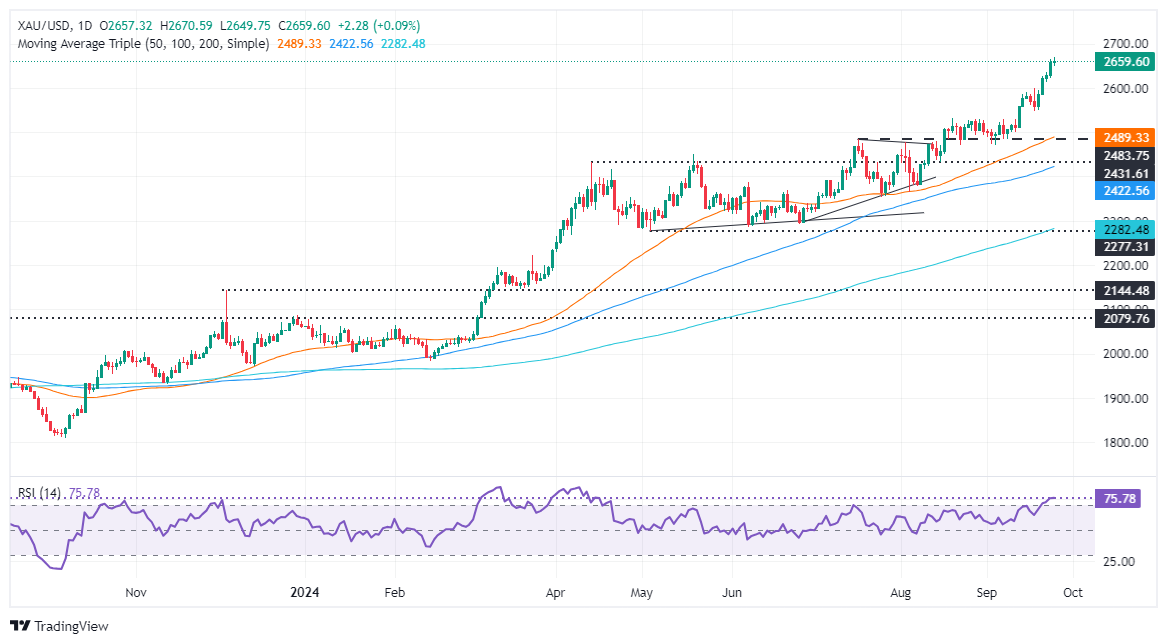- Gold price held steady at $2,660 after hitting a record high of $2,670.
- Traders assign a 60% probability to another 50bp Fed rate cut in November.
- US Treasury yields and a stronger US Dollar capped Gold’s upside despite bullish momentum.
Gold price held above $2,650 for the second consecutive session on Wednesday as traders raised the odds of another big interest rate cut by the Federal Reserve (Fed) at the upcoming meeting in November. That and high US Treasury yields kept the XAU/USD from rising further, and it traded mostly near $2,660, up 0.14%.
Market sentiment turned slightly negative during the US session as Wall Street traded in the red. Gold prices therefore hit a record high of $2,670 but retreated as US Treasury yields rose four and a half basis points (bps) to 3.775%.
Meanwhile, the US Dollar Index (DXY), which tracks the value of the greenback against six other currencies, rebounded from a 14-month low and rose 0.54% to 100.88.
During the week, US economic data showed that business activity in the manufacturing sector cooled while services remained resilient. However, a deterioration in Consumer Confidence by the Conference Board (CB) suggests that conditions in the labor market could be worse than projected.
Last week, the Fed cut borrowing costs by 50 bps to 4.75%-5.00%, and traders seemed confident of consecutive cuts of the same size. According to the CME FedWatch tool, the odds of a 50 bps Fed rate cut are 60%, while those of a 25 bps cut are 40%.
Gold prices had rallied by 29% in 2024, sponsored by physical demand for gold and major central banks beginning their easing cycles. This and geopolitical tensions could keep traders eyeing $2,700.
Gold is up more than 29% so far in 2024, with gains attributed to central bank easing and geopolitical woes.
Daily Moves and Market Movers: Gold Price Holds Firm Amid High US Yields
- Gold price capped by US Treasury yields
- Tensions in the Middle East between Israel and Hezbollah benefit gold prices.
- A lackluster U.S. economic calendar on Wednesday left traders adrift with past data as they prepared for Fed Chair Jerome Powell’s speech on Thursday.
- ETF flows, geopolitical tensions in the Middle East and massive stimulus measures from China could push gold prices higher.
- According to the World Gold Council, global physically-backed gold ETFs saw modest net inflows of 3 metric tons last week.
XAU/USD Technical Outlook: Gold Price Consolidates Around $2,650-$2,660
Gold prices are set to extend gains. However, price action turned sideways on Wednesday amid lack of catalysts, which could push XAU/USD above its current record high towards $2,700.
From a momentum perspective, the Relative Strength Index (RSI) signals that Gold is overbought, which could cause a decline before the rally resumes.
If XAU/USD extends its rally beyond the current year-to-date (YTD) peak of $2,670, look for a challenge at $2,675, followed by $2,700. Next would be the $2,750 level, followed by $2,800.
On the other hand, if XAU/USD drops below $2,650, look for a test of the September 18 daily high at $2,600. The next key support levels to test will be the September 18 low of $2,546, followed by the 50-day simple moving average (SMA) at $2,488.
Gold FAQs
Gold has played a pivotal role in human history as it has been widely used as a store of value and a medium of exchange. Today, apart from its luster and use for jewelry, the precious metal is considered a safe haven asset, meaning it is considered a good investment in turbulent times. Gold is also considered a hedge against inflation and currency depreciation as it is not dependent on any particular issuer or government.
Central banks are the largest holders of gold. In their aim to support their currencies in turbulent times, central banks tend to diversify their reserves and buy gold to improve the perception of the strength of the economy and the currency. High gold reserves can be a source of confidence in a country’s solvency. Central banks added 1,136 tonnes of gold worth about $70 billion to their reserves in 2022, according to data from the World Gold Council. This is the largest annual purchase on record. Central banks in emerging economies such as China, India and Turkey are rapidly increasing their gold reserves.
Gold has an inverse correlation with the US Dollar and US Treasury bonds, which are the main reserve and safe haven assets. When the Dollar depreciates, the price of Gold tends to rise, allowing investors and central banks to diversify their assets in turbulent times. Gold is also inversely correlated with risk assets. A rally in the stock market tends to weaken the price of Gold, while sell-offs in riskier markets tend to favor the precious metal.
Gold prices can move due to a wide range of factors. Geopolitical instability or fears of a deep recession can cause the price of Gold to rise rapidly due to its status as a safe haven asset. As a non-yielding asset, Gold prices tend to rise when interest rates fall, while rising money prices often weigh down the yellow metal. Still, most of the moves depend on how the US Dollar (USD) performs, as the asset is priced in dollars (XAU/USD). A strong Dollar tends to keep Gold prices in check, while a weaker Dollar is likely to push Gold prices higher.
Source: Fx Street
I am Joshua Winder, a senior-level journalist and editor at World Stock Market. I specialize in covering news related to the stock market and economic trends. With more than 8 years of experience in this field, I have become an expert in financial reporting.








